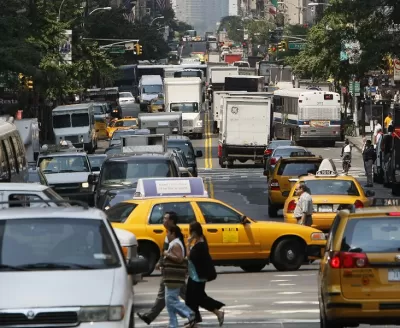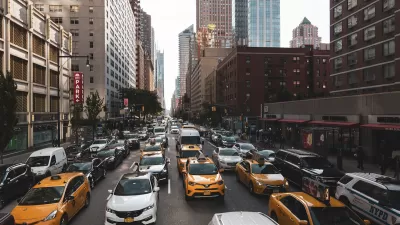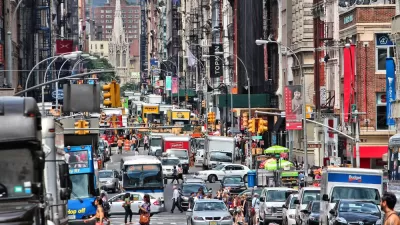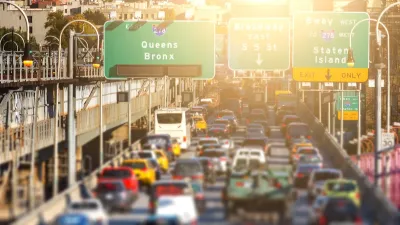After more than a decade of delays and reversals, congestion pricing is expected to take effect in Manhattan in late 2023 or early 2024.

The New York MTA earlier this week released the Environmental Assessment for the long-awaited congestion pricing scheme proposed for a section of Manhattan, reports Stephen Nessen for Gothamist.
The Central Business District Tolling Program Environmental Assessment (EA), which is available for public review, includes new details about how congestion pricing—more accurately described as cordon pricing—will work in Manhattan. “The congestion pricing assessment considered a range of tolling schemes for vehicles, including one that charged as little as $9 during peak hours,” explains Nessen. The high end of the range for private automobile owners could go to $23. “The tolls for commercial vehicles and trucks range from $12 to $82,” reports Nessen.
As for the other end of the equation, the congestion program is expected to raise $1 billion for improvements to public transit.
About 80% of the money raised would go toward subways and buses, with 10% to the Long Island Rail Road and 10% to Metro-North. The current capital plan stands at up to $56 billion, and revenue from the proposed congestion pricing plan would cover 30% of it. The MTA hopes to invest the $1 billion and generate $15 billion in total.
More background on the long road to this point for congestion pricing in New York City are included in the source article below, in addition to some discussion about the potential impact of congestion pricing on the public realm in the nation’s most populous city.
FULL STORY: MTA releases congestion pricing details, with fees that could be as high as $23 for drivers

Study: Maui’s Plan to Convert Vacation Rentals to Long-Term Housing Could Cause Nearly $1 Billion Economic Loss
The plan would reduce visitor accommodation by 25,% resulting in 1,900 jobs lost.

North Texas Transit Leaders Tout Benefits of TOD for Growing Region
At a summit focused on transit-oriented development, policymakers discussed how North Texas’ expanded light rail system can serve as a tool for economic growth.

Using Old Oil and Gas Wells for Green Energy Storage
Penn State researchers have found that repurposing abandoned oil and gas wells for geothermal-assisted compressed-air energy storage can boost efficiency, reduce environmental risks, and support clean energy and job transitions.

Santa Barbara Could Build Housing on County Land
County supervisors moved forward a proposal to build workforce housing on two county-owned parcels.

San Mateo Formally Opposes Freeway Project
The city council will send a letter to Caltrans urging the agency to reconsider a plan to expand the 101 through the city of San Mateo.

A Bronx Community Fights to Have its Voice Heard
After organizing and giving input for decades, the community around the Kingsbridge Armory might actually see it redeveloped — and they want to continue to have a say in how it goes.
Urban Design for Planners 1: Software Tools
This six-course series explores essential urban design concepts using open source software and equips planners with the tools they need to participate fully in the urban design process.
Planning for Universal Design
Learn the tools for implementing Universal Design in planning regulations.
Ascent Environmental
Borough of Carlisle
Institute for Housing and Urban Development Studies (IHS)
City of Grandview
Harvard GSD Executive Education
Toledo-Lucas County Plan Commissions
Salt Lake City
NYU Wagner Graduate School of Public Service





























